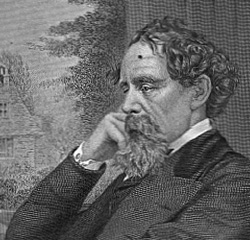









|
Chapter Seven English Literature of the
Victorian Age
I The Novels of Critical Realism
1. Charles Dickens (1812-1870)
Life
 Charles
Dickens, the greatest English critical realistic novelist, was born in 1812
at Portsmouth. His father was a clerk in the Navy Pay Office, who later got
involved in financial difficulties and was put into prison when Dickens was
12 years old. Then Dickens’ happy childhood ended and the boy had to give up
schooling to work in a shoe-blacking factory. Dickens suffered a lot there
and considered this experience as a humiliation. After his father was
released the boy returned to school again. However, at 15, he had to work in
a lawyer’s office as an office boy. There he visited the British Museum
Library to read books after work, gaining knowledge of shorthand and the
ability to distinguish enemies and evils which laws may not give a clear
distinction. Charles
Dickens, the greatest English critical realistic novelist, was born in 1812
at Portsmouth. His father was a clerk in the Navy Pay Office, who later got
involved in financial difficulties and was put into prison when Dickens was
12 years old. Then Dickens’ happy childhood ended and the boy had to give up
schooling to work in a shoe-blacking factory. Dickens suffered a lot there
and considered this experience as a humiliation. After his father was
released the boy returned to school again. However, at 15, he had to work in
a lawyer’s office as an office boy. There he visited the British Museum
Library to read books after work, gaining knowledge of shorthand and the
ability to distinguish enemies and evils which laws may not give a clear
distinction.
The skill of shorthand and the knowledge he
gained in the
British Museum Library prepared him to be a parliament
reporter for newspapers in about 1835. This experience enabled him to get a
good knowledge of the political life of contemporary England, to which he
showed his contempt. He also learned the skill of racy writing and of the
ability to know what would suit the popular taste.
In 1836, Dickens published a volume of
stories, Sketches by Boz. In 1837, his first novel Pickwick Papers
appeared and overwhelmingly swept across England when Dickens was 24. Then
he continued writing the rest of his life. With the continual publication of
excellent novels, his reputation and wealth grew rapidly and his position as
a classic writer was established. In his last years, he engaged himself in
public readings of his work. He died on June 9th, 1870, buried in the Poet’s
Corner at Westminster Abbey.
Three Period of Writing
Dickens together published 15 novels and a lot of short stories, travel
notes, etc. These works, especially his novels, truly presented a complete,
detailed and colorful picture of Victorian Age, and represented a new stage
in the development of English novels. Dickens depicted people in all social
strata, including their attitudes towards life and their fates. He showed
his contempt to social evils, sympathy for the weak and simple faith in
human beings. In order to study his works conveniently, Dickens’ literary
career was roughly divided into 3 periods. The following is a list of his
major works:
(I)
Sketches by Boz (1836)
The Posthumous Papers of the Pickwick Club (1836-1837)
Oliver Twist (1837-1838)
Nicholas Nickleby (1838-1839)
The Old Curiosity Shop (1840-1841)
Barnaby Rudge (1841)
(II)
American Notes (1842)
Martin Chuzzlewit (1843-1845)
A Christmas Carol (a Christmas book) (1843)
The Chimes (a Christmas book) (1844)
The Cricket on the Hearth (a Christmas book) (1845)
Dombey and Son (1846-1848)
David Copperfield (1849-1850)
(III)
Bleak House (1852-1853)
Hard Times (1854)
Little Dorrit (1855-1857)
A Tale of Two Cities (1859)
Great Expectations (1860-1861)
Our Mutual Friend (1864-1865)
Edwin Drood (unfinished) (1870)

|
![]()
![]()